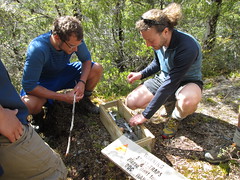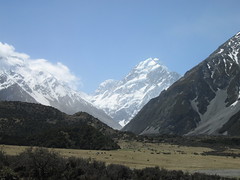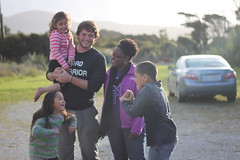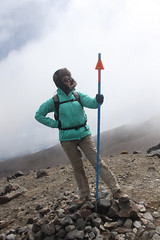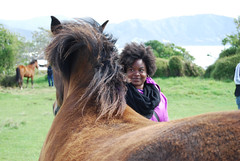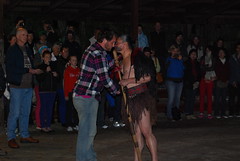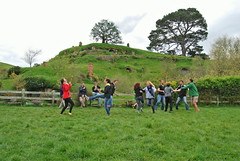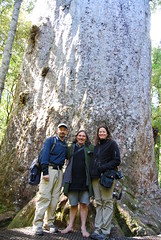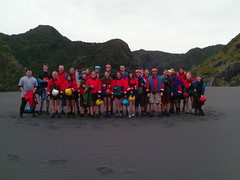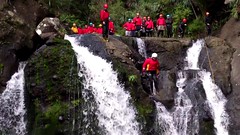December 5, 2012
As our semester draws to a close, our group has returned to the place we started: Motu Moana Boy Scout camp. I believe it was Eric King who referred to the cyclic nature of our trip as poetic, so I decided to write haiku (mostly as a joke) to describe the last week or so of our trip. The first one is describing the period of time we spent in the Catlins. We travelled there after leaving St. Margaret’s College; our home for the previous two weeks.
Outside is wet and dreary,
Inside I journal.
I forgot how to have fun.
The return to travel was strange after weeks of technology. It took a while to get back in the swing of things as we visited a farm. We were only in the Catlins for two days before travelling to Invercargill, a town famously referred to as the butthole of the world. There we visited an aluminum factory at Tiwai point and were able to see some long lived tuataras.
Tiwai future looks quite bleak
Failing industry
Tuataras are cool though.
After Invercargill and some bus breakdowns we traveled to Te Anau, where we saw the underground hydroelectric dam that powered the aluminum smelter, creating more than 15% of Aotearoa’s total energy. It’s not larger in scale only because of protests to save the lake it is run by, Lake Manapouri.
Tunnels delving to the deep,
Torrents of water,
Islands, a lake, serene above.
From there we intended to go to Milford Sound in fiordland, but were unable to due to closures. Instead, we headed to the adventure capital of the world, Queenstown. There we had a lot of free time and people did various activities including bungee jumping and New Zealand’s version of street luge (it is like downhill go-carting. I personally went on the luge and wrote this haiku about it.
Whizzing around curvy tracks,
Brakes are forgotten…
There’s a traffic jam of Asians.
Finally we have returned to where we began and I wrote a limerick to sum up how the semester has been.
Here it is spring rather than the fall
Seasons, toilets differ. And see all
This travel’s good for,
New cultures and more,
Then back to the scout bunks much too small.
– Elias Kehr
Until the Next Adventure
Our journey from Queenstown back to Auckland marked the beginning of the last stage of our New Zealand adventure. The South Island was incredibly beautiful and we were constantly surrounded by snowcapped peaks running down into crystal clear blue lakes, but returning to the North Island brought new excitement. In less than a week we will be flying from Auckland back to the United States. So now the countdown has begun, and I think I speak for everyone when I say how much I look forward to seeing friends and family back in the states. Yet, as our trip is concluding, I also find myself looking back upon my New Zealand experience and wondering what things I will remember most clearly and what I have learned. I am often scribbling into my journal any fleeting thoughts and details I am afraid of forgetting when I return home.
One aspect of our journey that will definitely stick with me is just how little I still know of other cultures and how much they know of mine. Here in New Zealand they follow the US election, and even our wider political world, and watch TV programs and movies that clearly reflect American culture. Yet how much do I pay attention to other countries around the globe? This realization has ignited a desire in me to travel and learn more. If New Zealand, a very modern and westernized place can teach me so much, I’d love to experience a culture even further from my comfort zone.
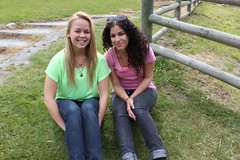 Another thing I will always have fond memories of is our group. They have consistently been quirky and fun and our dynamic is one that I will miss when we return to the states. As an only child, I have never been consistently surrounded by even one or two other people, so walking into a readymade family of over twenty was an adventure all its own for me. It is one I have appreciated and I am so thankful for the entertainment each and every one of them has provided at different stages in our trip. They made all of our big adventures like hikes, rafting, and marae stays, as well as the more mundane bus rides, and meals a memorable experience, and I am glad to have been a part of such a fun-loving group of people.
Another thing I will always have fond memories of is our group. They have consistently been quirky and fun and our dynamic is one that I will miss when we return to the states. As an only child, I have never been consistently surrounded by even one or two other people, so walking into a readymade family of over twenty was an adventure all its own for me. It is one I have appreciated and I am so thankful for the entertainment each and every one of them has provided at different stages in our trip. They made all of our big adventures like hikes, rafting, and marae stays, as well as the more mundane bus rides, and meals a memorable experience, and I am glad to have been a part of such a fun-loving group of people.
Of course this doesn’t even begin to cover all the things that have made this trip wonderful, but those are things you’ll just have to ask us about when we get home. Just know how excited we are to see all of you loved ones reading this at home, and New Zealand, it has been just wonderful getting to scratch your surface.
– Erica Garber
Personally I like being a nomad. To always be traveling somewhere, seeing new things and meeting new people, is an exciting way to spend three months. However, spending 2 to 3 hours or more on a bouncy bus every day with 21 other people equally as tired and grumpy from squeaky beds and loud snorers, can wear you down. My one motivating factor that saved me from throwing myself from the moving bus was that we were headed to Dunedin and we would be staying there for a whole TWO WEEKS – which seems like a lifetime compared to the one, two, and three night stays we were accustomed to. The road to Dunedin was like all other New Zealand roads: incredibly winding and steeply inclined. Such conditions make it extremely difficult to fall asleep as your head is constantly lolling from side to side and you might end up in someone’s lap or in the aisle of the bus. Anyways, I was especially excited to reach St. Margaret’s College at the University of Otago for several other reasons, one being we would each have our own rooms! This had only happened to me once before on the trip and it was the best three nights of my life! I would have room to throw my stuff all over the floor and not live out of a hiking backpack for once. Secondly, we had three meals a day, and they were prepared FOR us and there was NO dish washing involved!! Thirdly, we had no strictly regimented schedule to follow. There were a few speakers we had to listen to and a few other places to visit, but for the most part, the two weeks were ours (of course, we had to write a research paper in that time…)!
When we arrived at St. Margaret’s, we were all impressed by the lovely accommodations. It was by far the nicest place we stayed at in all our travels. We were all thankful that we hadn’t stayed there the first week; otherwise we would have been disappointed with the rest of the accommodations! I spent the next two weeks sleeping in and eating a lot, and wasting a lot of time on the free internet. I did manage to write a seven page paper in between my laziness, and to prepare a presentation along with it. We didn’t do a lot in Dunedin, but that was the best thing about it. We got to walk downtown to the octagon and spend money on clothes and gifts, experience the local nightlife, and play volleyball at the huge stadium complex on campus. We saw the steepest street in the world, and some of the more ambitious members of the group ran up it (not me). We also hid in man-made trenches to spy on the rare yellow eyed penguins as they fed their young by throwing up in their mouths. Yum.
Speaking of food, we also got to celebrate Thanksgiving here. The cook prepared us a special dinner in what he thought was an American Thanksgiving meal. Contrary to everyone’s loud praise for the meal, I was rather disappointed that there was no pumpkin pie! Dunedin was a time of relaxation and research and preparing ourselves to spend the last leg of our trip traveling in close quarters. Though the down time did allow for homesickness to creep in, I was able to use our time in Dunedin to refuel and motivate myself for the next two weeks.
-Laura Nyman
